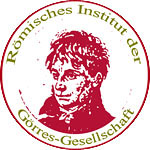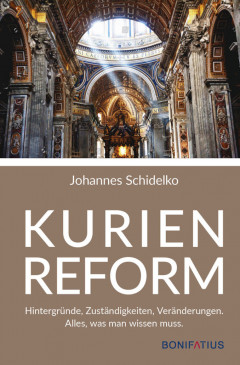Johannes Schidelko: reform of the curia
Johannes Schidelko, for 26 years head of the Community Office of the German-speaking Catholic News Agencies in Rome, member of the RIGG and also familiar with the Campo Santo Teutonico as an organist, has published a paperback on the background and processes of the recent Curia reform.
Schidelko presents a very useful book on the current state of the Curia and the Vatican. Now, apart from the Secretariat of State (which has been disempowered), there are only dicasteries of equal rank - administrative bodies. The main characteristic of the reform is the creation of centralised and pyramidically structured large authorities by merging smaller units. The "healthy decentralisation" (p. 30) refers to outside Rome.
The major Vatican authorities are listed individually by Schidelko, knowledgeably dissected and arranged around the central figure of Francis. Schidelko succeeds in naming the meandering paths of recent years, which have now been given form by decree. He dispenses with names (except for one). Thus the authorities remain anonymous, but the constantly changing personalities would have been of little use to the reader. The lack of names is, however, also indicative of the perception of the apparatus.
When reading, however, it quickly becomes clear that Francis has merged authorities, but that the work areas and processes are largely the same as before. Only some of the competences have been divided differently.
All in all, the 300 pages offer a great deal of interesting information. It is worth reading, and the book is also suitable as a reference work, even though it has no index. Reading fruits:
Managers "are prohibited from accepting gifts or other benefits worth more than 40 euros. Anyone who makes false declarations in this regard can be dismissed" (p. 263). At what point from the top is one considered a manager?
"An all too frivolous sale [of real estate, for example] (far below value), which some [religious] communities got involved in after the Council for the sake of the ideal of poverty, does not correspond to Catholic social teaching" (p. 158). Not a "poor Church of the poor" after all?
Then one learns about the "Rome borders": If a diocese or other church institution in Germany invests or sells more than 5 million euros, Rome must be asked first (p. 144).
There are 5,125 bishops in the world (p. 127). Hasn't it always been suspected: there is a shortage of priests, but no shortage of bishops!
So much for information picked at random from the rich trove of the book.
Finally, it may be noted that Schidelko is not concerned with a critical background analysis of the actors in the restructuring and redistribution of power in the Vatican apparatus, but with an evaluation of the official documents against the background of his own many years of reporting on the Curia. Thus, the good intention of the reform is presented with benevolence. In the epilogue, he rightly takes a sceptical look at the future (p. 292): The word "reform", which occurs a thousand times, is to be taken soberly and neutrally - whether a "reform" is an improvement, a worsening or just a continuation of the previous in a different guise is left to the judgement of future times and not least of the successor at the top.
- Details
- Written by: Stefan Heid
- Category: Recommended reading
 Römisches Institut der Görres-Gesellschaft
Römisches Institut der Görres-Gesellschaft







